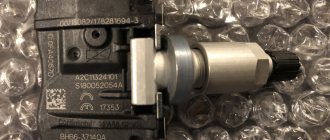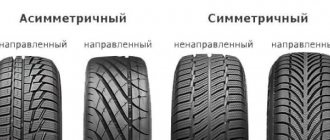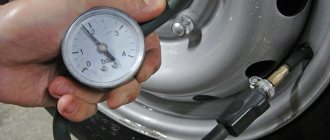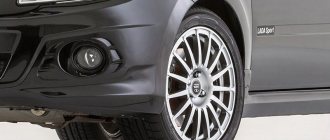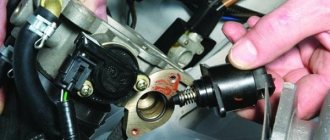Why check tire pressure?
The catalyst for many accidents is worn-out car tires, and the most serious tread damage occurs on overinflated or low tires.
In the first case, the center of the treadmill burns out - because of this defect, the braking distance increases and the number of accidents during emergency braking increases. In the second case, the edge of the tread wears off - this defect leads to loss of traction when maneuvering. However, incorrect tire pressure can lead to unpleasant consequences not only in the long term. A car driver who ignores the wheel control system signals faces the following problems:
- loss of dynamics - accelerating to 100 km/h in 7-10 seconds will no longer be possible;
- decreased controllability - the car skids when turning even on a dry road;
- increased fuel consumption - instead of the expected 4.6-9.8 per 100 km, the Mazda CX5 will “eat” up to 8-12 liters.
If the tire pressure monitoring sensor is on on the dashboard, do not ignore it, but try to deal with the problem that has arisen.
Tire pressure sensors Mazda CX 5
Insufficient or too high tire pressure leads to reduced vehicle safety, deterioration of dynamic characteristics and causes increased fuel consumption. Therefore, the Mazda CX 5 uses special sensors.
They promptly detect and inform the driver about deviations in tire pressure from the norm.
Installing a tire pressure sensor
Installation and binding of tire pressure sensors is carried out according to the algorithm below:
Typically, sensor binding occurs automatically. If this does not happen, then you need to move the engine start push-button switch to the ON position and then back to OFF or ACC. After this, you should pause for 15 minutes.
To register code signals from sensors and ensure correct operation of the system, you need to drive for 10-30 minutes at a speed of more than 25 km/h.
If the warning light does not go off, then you need to stop the car for 15-25 minutes and then continue driving for 10-30 minutes at a speed above 25 km/h.
If the binding does not occur, then the problem may be related directly to the sensor.
Checking the pressure sensor
You can check the functionality of the sensor by forcibly releasing some of the air from the wheel. In this case, after a while a message indicating that the tire pressure is too low should appear. Checking the TPMS system is also possible by reading errors from the on-board computer.
How does the Mazda CX5 tire pressure monitoring system work?
The wheel control system can be direct or indirect. The first technology relies on controllers built into the tire. The second system operates with data on the size of the wheel and the associated angular velocity. Mazda's designers opted for an indirect TPMS system.
The main components of the TPMS system are software and four sensors that monitor the angular speed of the wheel. A flat or overinflated tire changes its outer diameter, causing the angular speed to decrease or increase. The control sensor checks this indicator while driving, and the software compares the received data with the basic values. If the basic values deviate, the “Tire pressure error” signal lights up on the dashboard.
For the TPMS system to work, you need to initialize the software and sensors. Without prior activation and calibration, the number of false alarms increases (the signal will remain on even if the tire is correctly inflated).
How do sensors work in a Mazda CX-5?
In the Mazda CX-5, tire pressure monitoring (TPMS) is carried out simultaneously on all sides when the engine is started. The sensor lights up after the engine starts, going out after a few seconds. During this time, real indicators are checked and compared with the regulated ones. If there are no deviations, the system switches to passive tracking mode. There is no control during parking. Activation of the sensor while driving signals the need for immediate adjustment. After adjusting the indicator to the standard value, the signal light goes out.
Read also: Brake discs for kia ceed jd
The system may fail or hide the problem when:
1) simultaneous use of different types of tires or unsuitable wheel sizes for Mazda CX-5.
2) Tire puncture.
3) Driving on bumpy or icy roads.
4) Driving at low speeds.
5) Traveling short distances.
According to the diameter of the tires, the pressure in the Mazda CX-5 r17 tires should be 2.3 atmospheres; for the R19, 2.5 atmospheres is considered the norm. The indicator is identical for the front and rear axles of the car. These values are regulated by the manufacturer and specified in the technical documentation.
Tires can deflate over time by exchanging air with the environment through the pores of the rubber. In summer tires for the Mazda CX-5, the pressure increases with increasing temperature, but in winter this figure drops by an average of 0.2-0.4 atmospheres per month.
The operation of the sensors is not affected by which tires are installed on the Mazda CX-5 (R17 or R19). Even when replacing tires or wheels, the system automatically changes settings and calibrates data for new operating conditions.
Regular tire pressure is the key to safety on the road and extends the life of the rubber. The electronic TPMS system in the Mazda CX-5 promptly informs the driver of deviations from regulated standards.
Insufficient or too high tire pressure leads to reduced vehicle safety, deterioration of dynamic characteristics and causes increased fuel consumption. Therefore, the Mazda CX 5 uses special sensors.
They promptly detect and inform the driver about deviations in tire pressure from the norm.
Popular tire models
- Yandex.Market rating: Yandex.Market: 4.5
Goodyear Eagle Sport TiresSeasonality: summer Spikes: no Diameter: 14 / 15 / 16
- Yandex.Market rating: Yandex.Market: 4.5
Goodyear UltraGrip Ice+ tires
Seasonality: winter Spikes: no Diameter: 14 / 15 / 16 / 17
- Yandex.Market rating: Yandex.Market: 4.5
Goodyear EfficientGrip Performance Tires
Seasonality: summer Spikes: no Diameter: 15 / 16 / 17 / 18 / 19 / 20
- Yandex.Market rating: Yandex.Market: 4.5
Goodyear UltraGrip Ice 2 tires
Seasonality: winter Spikes: no Diameter: 14 / 15 / 16 / 17 / 18 / 19
- Yandex.Market rating: Yandex.Market: 4.5
Goodyear Vector 4Seasons tires
Seasonality: all-season Spikes: no Diameter: 14 / 15 / 16 / 17 / 18
- Yandex.Market rating: Yandex.Market: 4.5
Goodyear Eagle Sport TZ tires
Seasonality: summer Spikes: no Diameter: 16 / 17 / 18
- Goodyear UltraGrip Arctic 2 tires
Seasonality: winter Spikes: yes Diameter: 16 / 17 / 18 / 19
- Yandex.Market rating: Yandex.Market: 4.5
Goodyear UltraGrip Ice SUV Tires
Seasonality: winter Spikes: no Diameter: 16 / 17 / 18 / 19 / 20
- Goodyear UltraGrip Arctic 2 SUV Tires
Seasonality: winter Spikes: yes Diameter: 17 / 18 / 19 / 20 / 21
- Yandex.Market rating: Yandex.Market: 4.5
Goodyear Wrangler All-Terrain Adventure tires with Kevlar
Seasonality: summer Spikes: no Diameter: 15 / 16 / 17 / 18 / 19 / 20
- Yandex.Market rating: Yandex.Market: 5
Goodyear Eagle Sport SUV TZ tires
Seasonality: summer Spikes: no Diameter: 17 / 18
- Yandex.Market rating: Yandex.Market: 4
Goodyear Wrangler HP All Weather Tires
Seasonality: summer Spikes: no Diameter: 15 / 16 / 17 / 18 / 19
- Yandex.Market rating: Yandex.Market: 4.5
Goodyear EfficientGrip SUV Tires
Seasonality: summer Spikes: no Diameter: 16 / 17 / 18 / 19 / 20 / 21 / 22
- Yandex.Market rating: Yandex.Market: 4
Goodyear UltraGrip Performance 2 Tires
Seasonality: winter Spikes: no Diameter: 16 / 17 / 21
- Yandex.Market rating: Yandex.Market: 5
Goodyear Eagle F1 SuperSport Tires
Seasonality: summer Spikes: no Diameter: 18 / 19 / 20 / 21
- Yandex.Market rating: Yandex.Market: 4.5
Goodyear Eagle F1 Asymmetric 3 SUV tires
Seasonality: summer Spikes: no Diameter: 17 / 18 / 19 / 20 / 21 / 22
- Goodyear Eagle F1 SuperSport RS Tires
Seasonality: summer Spikes: no Diameter: 21
How to initialize a TPMS system - step-by-step guide
- Inflate all four tires of your Mazda CX5 to the recommended internal pressure. For R17 format tires the recommended value is 2.3 bar, for R19 - 2.5 bar.
- Insert the key into the ignition. Turn it to the ON position and return it to LOCK. This way you activate the on-board network to which the air control system is connected.
- Wait at least 15 minutes. During this time, the on-board computer will catch the sensor signal, read its ID and register the bus controller. If you want to play it safe, wait 20 minutes.
- Start the car, start driving and pick up speed up to 25 km/h. Maintain this speed for 10 minutes while driving on a level road.
- Check the TPMS system indicator - it should show the correct pressure. If an error signal is on on the panel, press the TPMS SET button, which will reset the controller binding. After the reset, repeat the binding according to the described scheme.
I can't turn off the tire pressure light in my Mazda. What am I doing wrong?
MX-5
Hello, dear reader!
The Nippon Service
channel presents true stories from the practice of operating, diagnosing and repairing Mazda cars.
In this episode I will discuss the conditions under which the TPMS
why it comes on and how to properly initialize the system. The Tire Pressure Monitoring System (
TPMS
the ABS/DSC
wheel speed sensors .
Block diagram of TPMS.
Since 2012, this system has replaced the previous one, which used wheel pressure sensors. Information about a flat tire is sent to the ABS/DSC
from the wheel sensor in the form of a change in the signal profile and wheel speed (a flat tire has a smaller rolling radius).
If the air pressure in one or more tires is too low compared to the set value (the initial value received by the unit), the system warns the driver using the TPMS
on the instrument cluster and sound signal.
Dashboard.
To TPMS
function correctly, it is important that
the TPMS
is initialized to learn new conditions whenever tire-related service (rotation, pressure adjustment, tire/wheel replacement,
battery
ABS/DSC
unit disconnection ) is performed.
The system is initialized in the following way. Need to press and hold the TPMS
on the left panel until the
TPMS
on the instrument cluster flashes once or twice and the warning horn sounds once.
After this, you need to drive at a speed of 50±10 km/h on a flat road, avoiding sharp turns and braking for 20 minutes. At this point, the block learns the new value of the wheel signal profiles. To complete the training, you must turn off the ignition, close the car doors and let it sit for more than 5 minutes.
A special feature of the system is that in the ABS/DSC
the calibrated tire profile of the wheel with the specified, reference pressure is not recorded. And every time you carry out initialization, you give the block your reference pressure profile for your wheels. A 25% pressure drop will be calculated relative to it and the control lamp will be turned on.
Therefore, if you inadvertently press the setting switch without adjusting the pressure, the warning light may come on after a while. This happens because during the operation of the car, the pressure drop from the initiated one may fall not by 25%, but by 20%, and after pressing the switch it could become the new base one. This situation may cause an accident.
Therefore the ABS/DSC
has two types of system switch misuse prevention logic:
type A
and
type B.
Type A
2012-2013 CX-5
vehicles
ABS/DSC
unit catalog numbers whose first 4th digits begin with
K011
or
K0Y1
. And they light the lamp after the first press.
You can reset the false alarm by inflating the tires with nominal pressure + 0.5 kg/cm2 (50 kPa), carry out the initialization described above, return the pressure to normal and initialize again.
Type B
all other cars use. The first time the switch is accidentally pressed, nothing happens, but the second time the lamp lights up.
False alarms of type B are reset using a diagnostic tool, be careful.
Safe roads and good service
!
When does the control system fail?
The indirect TPMS system is not a 100% reliable method of pressure control. It happens that it gives an error in which the signal is on, and the pressure in the wheel is normal. Most often, such a failure occurs when tires of different models are installed on car rims. Another reason may be driving on a bumpy road, during which the wheel dimensions change for natural reasons. The error can also be seen when taking a turn in a long arc.
The sensor does not operate at speeds below 25 km/h, or when tires with rigid sides (Run-Flat models) are installed on the vehicle. Another reason for the lack of a signal may be the replacement of the disk, during which they forgot to install the angular velocity controller.
